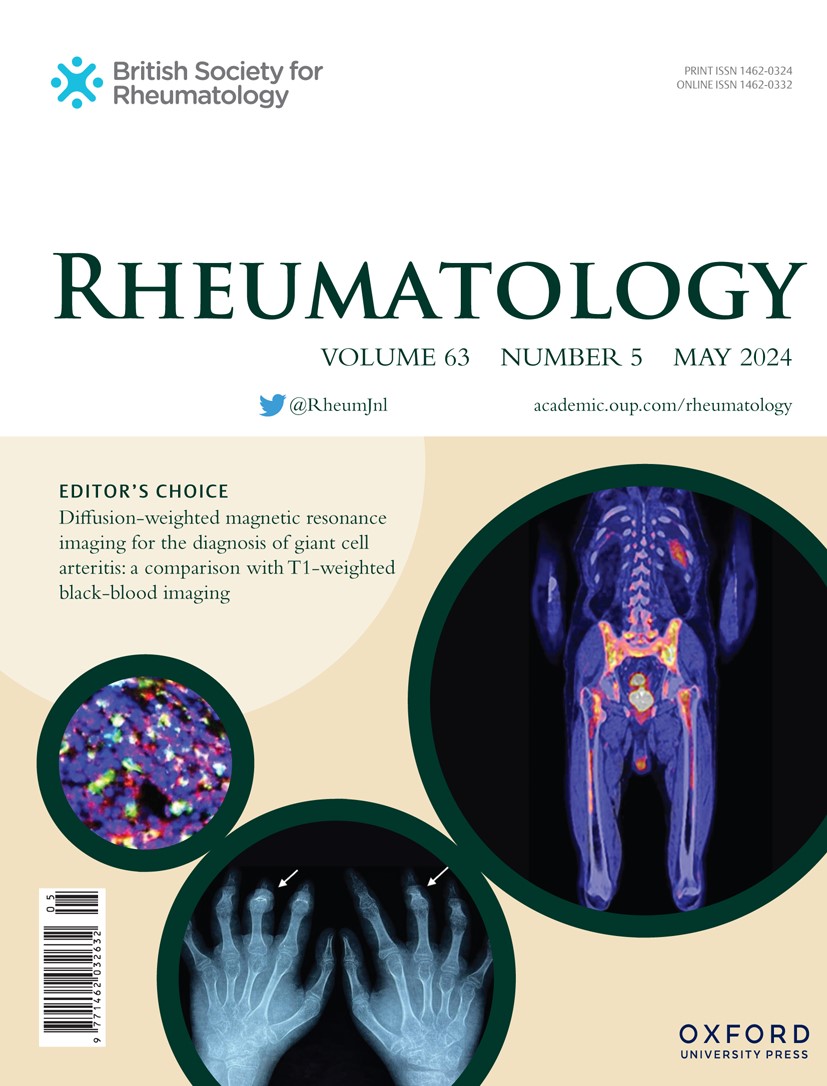OA01 Long-term cardiovascular safety of febuxostat compared with allopurinol or no urate-lowering treatment in people with gout: a cohort study in UK primary care using the Clinical Practice Research Datalink
IF 4.7
2区 医学
Q1 RHEUMATOLOGY
引用次数: 0
Abstract
Background/Aims Febuxostat is recommended as first line urate-lowering therapy (ULT) for gout in the UK. However, concerns were raised regarding its cardiovascular (CV) safety. Current guidance advises caution when using it in people with CV disease, potentially denying people an effective treatment. Randomised trials have shown no difference in CV outcomes between febuxostat and allopurinol, but did not include a control group who did not receive ULT. This study compared CV safety in people with gout who received allopurinol, febuxostat or no ULT. Methods Retrospective cohort study, using data from the Clinical Practice Research Datalink (CPRD) and Hospital Episode Statistics (HES) datasets. Adults aged ≥40 years with a SNOMED code for gout between 17/12/2008 and 31/03/2021 were included. We compared those prescribed (1)febuxostat, (2)allopurinol, or (3)no ULT. Individuals were considered at risk from index date until the earliest of first outcome event, death, end of treatment period or 31/03/21. Primary outcome was a composite of major CV events (myocardial infarction, ischaemic stroke, admission with heart failure, unstable angina, revascularisation and cardiac mortality), secondary outcomes assessed these individually. The incidence rate of each outcome in all three groups are presented with 95% confidence intervals (CI). The association between receiving either ULT, compared to those who received no prophylaxis, and first occurrence of each outcome was investigated using a multivariable Cox proportional hazards model, adjusting for sex, age, previous CVD, ethnicity, hypercholesterolaemia, social deprivation, BMI, smoking status, co-prescriptions in the two months prior to index date and number of gout consultations and hospitalisations in the 12 months prior to index date. Results 7,378 participants who were prescribed febuxostat and 97,940 who were prescribed allopurinol were compared with 200,387 who received no ULT. The groups were similar in age and sex distribution. Febuxostat users were more likely to have attended either primary or secondary care with gout in the 12 months prior to index date, had more co-prescriptions in the two months prior to index date, but were less likely to have received flare prophylaxis (33.3% vs 40.1%) compared with those who received allopurinol. The rate of primary outcome (per 1,000 person years, 95% CI) was higher in febuxostat users (66.01 (61.41, 70.97)) than those who received allopurinol (51.86 (50.85, 52.89)) or no ULT (40.13 (39.45, 40.81)). In the fully adjusted model, the composite primary outcome did not differ between febuxostat users and those not receiving ULT (hazard ratio (HR) 0.93 (95% CI 0.86-1.00)), whereas allopurinol was associated with slightly higher risk than no ULT (HR1.13(1.10-1.16)). Conclusion Febuxostat does not appear to increase the risk of major CV adverse events when used as ULT for patients with gout compared with not receiving ULT. These findings provide reassurance about using febuxostat in people with gout. Disclosure R. Partington: None. S. Muller: None. C.D. Mallen: None. M.A. Mamas: None. H. Forrester: None. E. Roddy: None.非布司他与别嘌呤醇或无降尿酸治疗在痛风患者中的长期心血管安全性:一项使用临床实践研究数据链的英国初级保健队列研究
背景/目的:在英国,非布司他被推荐作为一线降尿酸治疗(ULT)。然而,人们对其心血管(CV)安全性提出了担忧。目前的指南建议在心血管疾病患者中谨慎使用,这可能会使患者无法获得有效治疗。随机试验显示,非布司他和别嘌呤醇之间的CV结果没有差异,但不包括未接受ULT治疗的对照组。该研究比较了接受别嘌呤醇、非布司他或不接受ULT治疗的痛风患者的心血管安全性。方法回顾性队列研究,使用临床实践研究数据链(CPRD)和医院事件统计(HES)数据集的数据。在2008年12月17日至2021年3月31日期间,年龄≥40岁,痛风SNOMED代码的成年人被纳入研究。我们比较了(1)非布司他,(2)别嘌呤醇,或(3)无ULT。从指标日起至最早出现第一结局事件、死亡、治疗期结束或21年3月31日,个体被认为存在风险。主要结局是主要心血管事件(心肌梗死、缺血性卒中、心力衰竭入院、不稳定型心绞痛、血运重建和心脏死亡率)的复合,次要结局分别对这些事件进行评估。所有三组中每种结局的发生率均以95%置信区间(CI)表示。使用多变量Cox比例风险模型调查接受任何一种ULT与未接受预防的患者之间的关系,并对性别、年龄、既往心血管疾病、种族、高胆固醇血症、社会剥夺、BMI、吸烟状况、指数日期前两个月的联合处方以及指数日期前12个月的痛风咨询和住院次数进行调整。结果:7378名服用非布司他的参与者和97940名服用别嘌呤醇的参与者与200387名未服用非布司他的参与者相比。这些群体在年龄和性别分布上相似。非布司他使用者更有可能在索引日期之前的12个月内接受初级或二级痛风护理,在索引日期之前的两个月内有更多的联合处方,但与接受别嘌呤醇的患者相比,接受耀斑预防的可能性更低(33.3%对40.1%)。非布司他服用者的主要转归率(每1000人年,95% CI)(66.01(61.41, 70.97))高于别嘌呤醇服用者(51.86(50.85,52.89))或无ULT(40.13(39.45, 40.81))。在完全调整的模型中,复合主要结局在非布司他使用者和未接受ULT的患者之间没有差异(风险比(HR) 0.93 (95% CI 0.86-1.00)),而别嘌呤醇的风险比未接受ULT的患者略高(HR1.13(1.10-1.16))。结论:与未接受ULT治疗的患者相比,非布司他作为ULT治疗痛风患者时,似乎不会增加主要CV不良事件的风险。这些发现为痛风患者使用非布司他提供了保证。帕廷顿:没有。穆勒:没有。C.D.马伦:没有。玛:没有。弗雷斯特:没有。E.罗迪:没有。
本文章由计算机程序翻译,如有差异,请以英文原文为准。
求助全文
约1分钟内获得全文
求助全文
来源期刊

Rheumatology
医学-风湿病学
CiteScore
9.40
自引率
7.30%
发文量
1091
审稿时长
2 months
期刊介绍:
Rheumatology strives to support research and discovery by publishing the highest quality original scientific papers with a focus on basic, clinical and translational research. The journal’s subject areas cover a wide range of paediatric and adult rheumatological conditions from an international perspective. It is an official journal of the British Society for Rheumatology, published by Oxford University Press.
Rheumatology publishes original articles, reviews, editorials, guidelines, concise reports, meta-analyses, original case reports, clinical vignettes, letters and matters arising from published material. The journal takes pride in serving the global rheumatology community, with a focus on high societal impact in the form of podcasts, videos and extended social media presence, and utilizing metrics such as Altmetric. Keep up to date by following the journal on Twitter @RheumJnl.
 求助内容:
求助内容: 应助结果提醒方式:
应助结果提醒方式:


